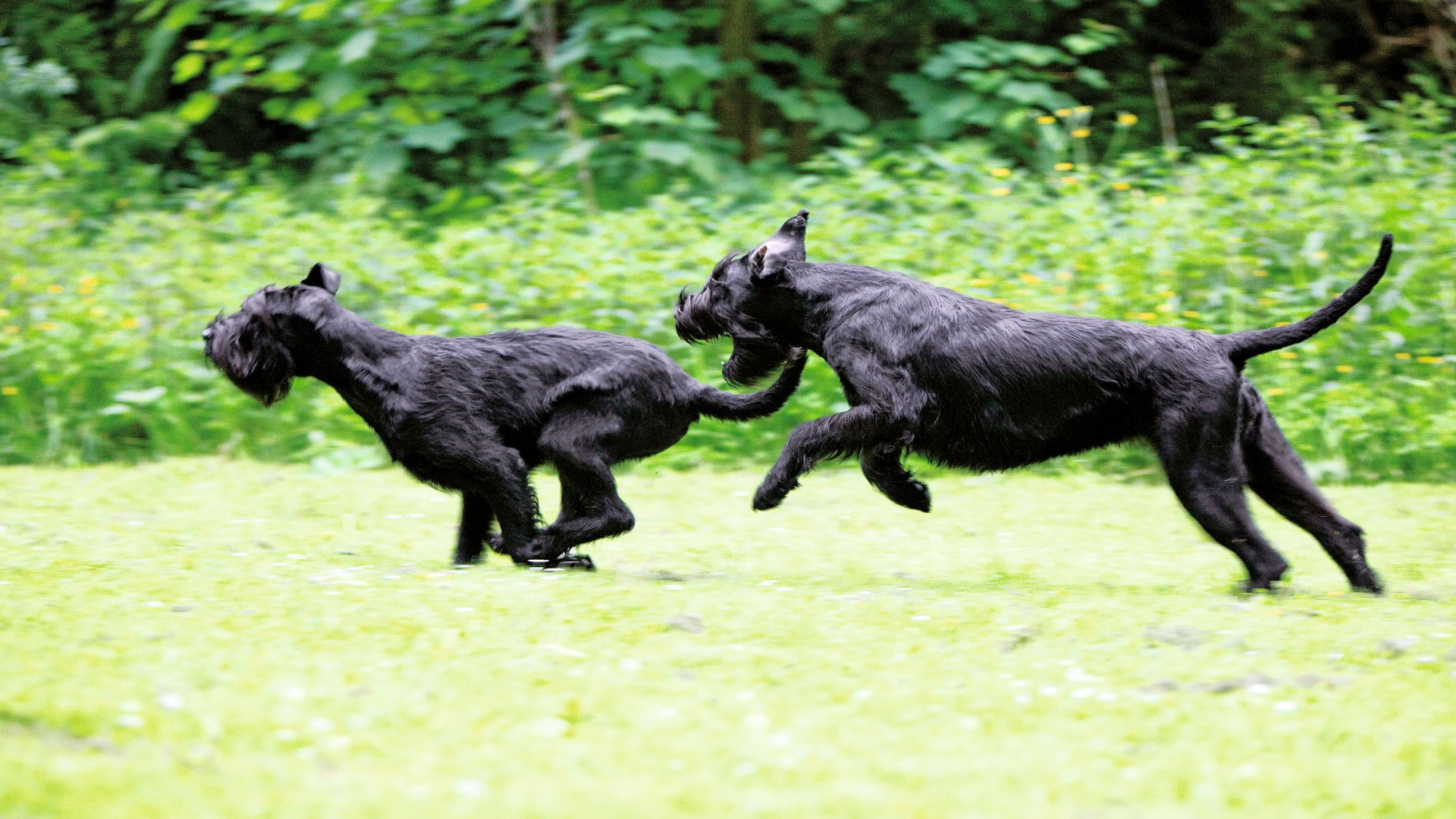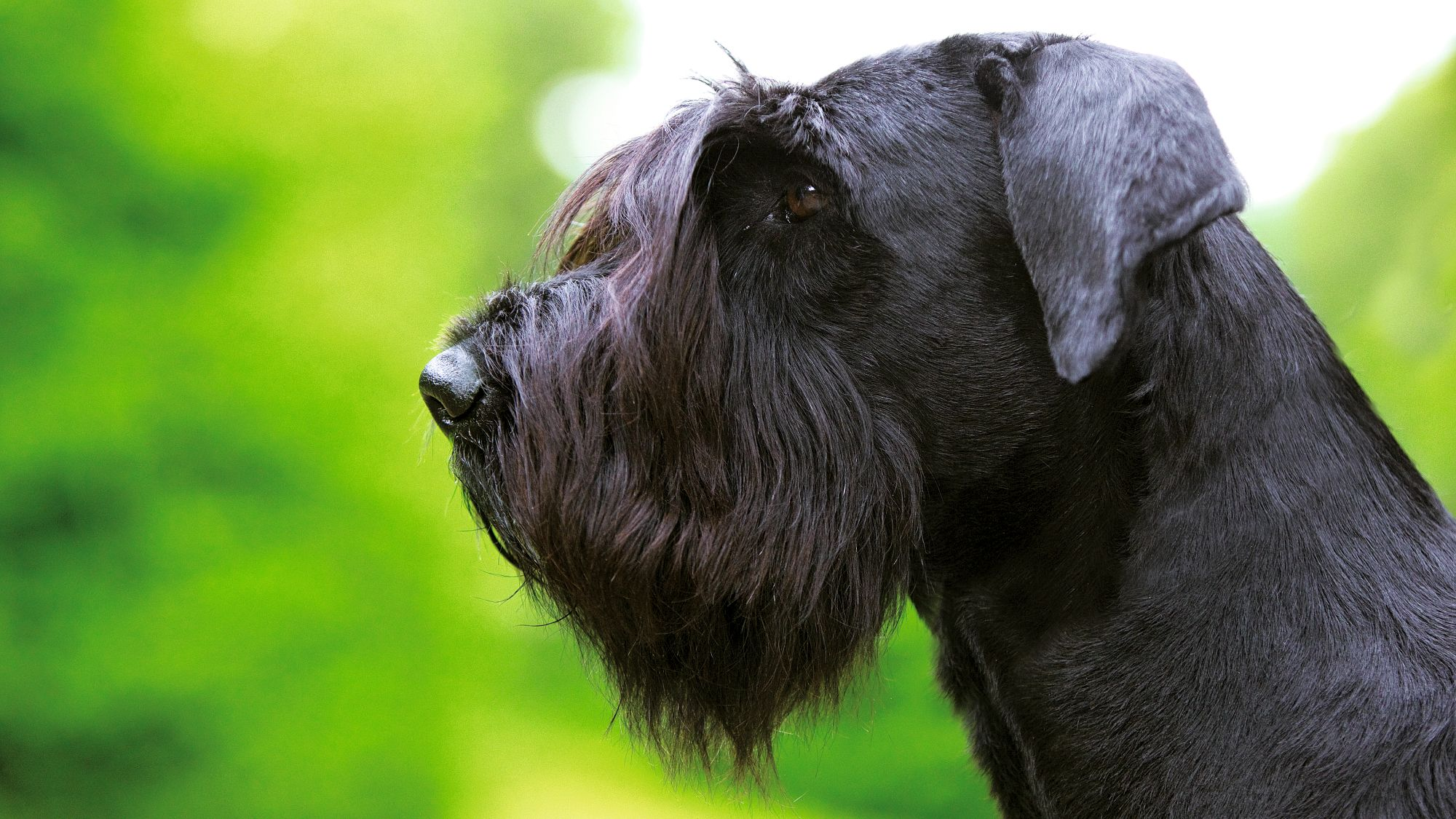
Let's talk Giant Schnauzers
The Giant Schnauzer seems to have it all: Good looks, a winning wardrobe, and a confident air. This majestic dog isn’t a giant breed but merely the largest of the trio of Schnauzers, along with the Miniature and the Standard. Alert and devoted, with focused eyes visible behind their characteristic beard and eyebrows, this working breed is most at ease with a job to do. The Giant Schnauzer’s size may be commanding but don’t be fooled: playtime is always at the top of their agenda.Official name: Giant Schnauzer
Other names: Munich Schnauzer, Munchener, Russian Bear Schnauzer
Origins: Germany

| Drooling tendencies |
|
Warm weather? |  |
| Shedding level |  |
Suited to apartment living? | |
| Energy Level (high, low, medium)* | High | Family Pet?* |
|
| Compatibility with other pets | Can stay alone?* | 
|
* We advise against leaving pets alone for long stretches. Companionship can prevent emotional distress and destructive behaviour. Speak to your veterinarian for recommendations.
Every pet is different, even within a breed; this snapshot of this breed specifics should be taken as an indication.
For a happy healthy and well-behaved pet, we recommend educating and socializing your pet as well as covering their basic welfare needs (and their social and behavioral needs).
Pets should never be left unsupervised with a child.
Contact your breeder or veterinarian for further advice.
All domestic pets are sociable and prefer company. However, they can be taught to cope with solitude from an early age. Seek the advice of your veterinarian or trainer to help you do this.


| Baby age | Birth to 2 months |
| Puppy age | 1 to 15 months |
| Adult age | 15 months to 5 years |
| Mature age | 5 to 8 years |
| Senior age | from 8 years |

1/7
Get to know the Giant Schnauzer
All you need to know about the breed
The glorious Giant Schnauzer is a sight to behold. Standing at nearly 28 inches (70cm) at the shoulder and graced with an earnest expression, this dog was used at their start on farms in the German countryside to drive livestock and guard stables - and even used to catch rats in their spare time. With a noble bearing and ever-eager demeanour, they’ve made their way into the hearts of Bavarians as well as dog lovers the world over.
Giant Schnauzers enjoy movement of any kind - whether it’s work or play - and have gladly participated in Schutzhund, the German competition for tracking, obedience, and protection. A huge intellect has helped them excel at it, and their dignified corporeal stature has carried over into less physical competition on the show dog circuit.
No matter what, their main preoccupation is having a job, even if it’s a game of fetch in the yard. The breed is an excellent choice too if you’re sporty. Take them hiking or running, they’re upbeat and always up for it. The Giant Schnauzer will be best matched to lively, on-the-move owners.
The Giant Schnauzer’s temperament is also outstanding. They’re known to be considerate, gentle, and loyal, but size does matter: They are probably best for a household with older children who may not be so easily, and accidentally, knocked down. The breed can be assertive with people or dogs they’re not familiar with so early socialisation is a must for them.
Then there’s the scruffy beard and bushy eyebrows, the Schnauzer breed’s recognisable trait, which looks even better on the Giant Schnauzer. “Schnauze” is German for “muzzle”, the perfect word for a breed whose spirited dark eyes convey the warmth they possess in spades.

2/7
2 facts about Giant Schnauzers
1. Getting away with it
Highly intelligent and alert, the Giant Schnauzer breed is a pleasure but will easily outfox you - if he can, and if you’re not aware. Keep them stimulated with loads of exercise within a large property or fenced-in yard and activities that will stimulate their very active mind.
2. An indoors sort
Despite their legacy as a dog used for guarding, the Giant Schnauzer is a companion dog and should not be left tied up or leashed out of doors. They prosper most by being at the side of their family and can easily become bored or destructive if left alone or without a task to do.
History of the breed
The Giant Schnauzer breed originated in Germany in the mid-1800s in the states of Bavaria and Wurttemberg where it had originally been called the Haired Pinscher. Schnauzers are a perpetual favorite in the dog world and a variety of breeds, along with the Standard Schnauzer, were used to develop a larger dog that could drive cattle to market, including the Black Great Dane, Bouvier des Flandres, and German Pinscher.
With the onset of the railroad toward the end of the 1900s, the breed was put to use guarding butcher shops, stockyards, and breweries.
As the 20th Century dawned, the Giant Schnauzer found a new role as a police and military dog, their size and muscular frame being a suitable fit. Although the Giant Schnauzer Club of America was founded in 1962, they’re not commonly seen in the United States. The breed was accepted into the American Kennel Club in 1971.

4/7
From head to tail
Physical characteristics of Giant Schnauzers
1. Oreilles
Des oreilles tombantes, sans être lourdes, encadrent la tête du chien
2. Pelage
Poil court et dense sur un sous-poil imperméable
3. Fourrure
La fourrure peut être noire, chocolat ou blonde (du crème claire au roux)
4. Queue
La queue en position bien haute est naturellement longue et remue presque continuellement tout comme le corps parfois qui peut remuer en entier.
5. Pattes et colonne vertébrale
Le corps est bien proportionné, avec un bon équilibre entre la longueur des pattes et celle de la colonne vertébrale.

5/7
Things to look out for
From specific breed traits to a general health overview, here are some interesting facts about your Giant Schnauzer

6/7
Caring for your Giant Schnauzer
Grooming, training and exercise tips
Good grooming will be essential for your Giant Schnauzer. Their lengthy double coat demands brushing a few times a week and the thick, wiry outer coat should be stripped with a stripping comb as needed to remove any of the harsh stray hairs. Of course a trip to the canine barber to keep their handsome facial hair well-kept never hurts either. This breed needs a good amount of exercise every day as they have energy to burn. The Giant Schnauzer shines in agility sport competitions so will do the same, at minimum, on long daily walks or romps in the yard, especially if another canine is involved. Training the Giant Schnauzer? Simple! They are enthusiastic dogs who really enjoy having something to do, and if that’s a command from their favourite human, all the better. Any reprimands however should be given with equal enthusiasm, never harshness, as the breed is too smart for that and may not comply.7/7
All about Giant Schnauzers
The Giant Schnauzer has a legacy as an excellent watchdog and can be wary of animals and people they’re not familiar with. Proper socialisation is imperative in order to accustom them to the new and different. Hugely playful, this is one breed that will be giving paw and playing fetch soon enough with anyone who will play along. With their great temperament, the Giant Schnauzer has traditionally been used as a therapy dog, such is their gentle and affectionate side.
As Mother Nature would have it, the Giant Schnauzer comes in but two colourations: black, and a pattern called pepper and salt. The latter is seen as banded hairs of black and white covering the body, giving the appearance that the dog has been “peppered” and “salted”. A well-seasoned canine indeed!
Read more on this topic


How to adopt a dog

Things to consider before getting a dog
Sources
1 - Veterinary Centers of America https://vcahospitals.com/
2 - Royal Canin Dog Encyclopaedia. Ed 2010 and 2020
3 - Banfield Pet Hospital https://www.banfield.com/
4 - Royal Canin BHN Product Book
5 - American Kennel Club https://www.akc.org/
